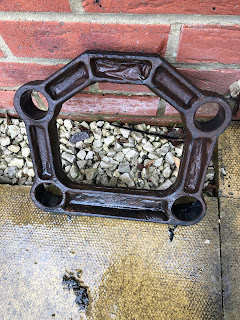Further internet research suggested welding a plate onto the front of the bearing which would a) allow the use of a straight drift to drive the bearing out from behind (rather than using an angled implement to try and get into the slots behind the bearing) and b) the weld apparently acts to shrink the bearing slightly making it easier to drive out.
Deciding to give this method a try, I purchased some a 300mm length of 20mm by 5mm steel strip and a 200mm length of 20mm did steel bar from eBay.
Using one of the taper bearing races that I had managed to extract as a template, I cut a length of the steel plate and ground down the ends to fit inside the bearing race (including chamfering the ends to account for the taper).
 |
| Marked up..... |
 |
| Cut..... |
 |
| Grinding.... |
 |
| Final Result |
I decided to tack weld the steel bar onto the back of the plate to make a more solid piece to be able to hopefully hammer the bearing out so I also chamfered the bottom of the bar slightly to facilitate tack welding.
 |
| Ready for welding... |
 |
| Plate tacked onto bar... |
I then attempted to weld the plate into the offending bearing race. This proved to be more difficult than I thought. Not sure whether it is because the race is hardened steel or that my welder is not powerful enough (or both), but the first few attempts to weld the plate in resulted in a lot of weld being deposited on the plate and very little on the bearing race. I had to try several times, grinding off the weld deposit from my make-shift drift and rewelding. Eventually I managed to get a welded connection of some sorts between the plate and the bearing race.
 |
| Not pretty.... |
So armed with my trusty lump hammer it was time to get this bearing race out. Placing the hub on the ground and gave the protruding bar a couple of heavy duty blows. Eventually I was rewarded by the bar shifting and I turned the hub over expecting to finally see some movement of the bearing race.
Not a chance - unfortunately all I had achieved was to crack the welds between the plate and the race (demonstrating that my welding had achieved zero penetration into the hardened steel race).
I tried a couple more times to weld the plate in again but the result was the same each time - my welder could just not get enough heat into the bearing to get any weld penetration and after a few blows with the hammer, my home-made drift simply parted company with the bearing.
I gave Ben at Simply Performance a call and he acknowledged that these bearings can sometimes be a complete pain to remove. His suggestion was to heat the rear hub up and then dunk it into an oil bath, to repeat this a few times and then to try drifting the bearing out.
Determined to not let this bearing beat me I was all for giving this method a go, but when I was up at AK before Christmas I mentioned my dilemma to Jon who recommended just running a really hot bead of weld around the bearing to shrink it (as per my original thought) and offered to help me out if I brought my hub in.
So a couple of weeks back I drove up to AK with my hub and in less than 5 minutes Jon had welded round the bearing (with a welder about 10 times the size of mine) and drifted it out with ease!!! I didn't even have time for a cup of tea before I was back out of the factory!!!!
I reckon I must have put at least 10-12 hours of effort into shifting that bearing (probably more). It just shows that having the right gear can make such a difference. In fact the difference in welding power between my hobby welder and the AK industrial welder was clear when Jon handed the hub back to me and it was so hot I could barely hold it!!
So the bearing is out and I think that completes the strip-down of the rear end. (I still have to drill out the brake shield retaining screws from when I sheared the heads off - but I'll deal with that as part of the rebuild).
 |
| Finally - last taper bearing removed. Happy Days!!! |
















































